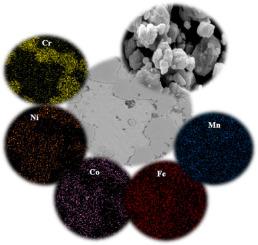当前位置:
X-MOL 学术
›
Mater. Chem. Phys.
›
论文详情
Our official English website, www.x-mol.net, welcomes your
feedback! (Note: you will need to create a separate account there.)
The effect of processing parameters and heat-treatment on the microstructure and mechanical properties of PM CoCrFeMnNiTi0.1 high-entropy alloy
Materials Chemistry and Physics ( IF 4.3 ) Pub Date : 2021-01-01 , DOI: 10.1016/j.matchemphys.2020.123722 Parisa Akhlaghi , Mostafa Amirjan , Nader Parvin
Materials Chemistry and Physics ( IF 4.3 ) Pub Date : 2021-01-01 , DOI: 10.1016/j.matchemphys.2020.123722 Parisa Akhlaghi , Mostafa Amirjan , Nader Parvin

|
Abstract CoCrFeMnNiTi0.1 high-entropy alloy (HEA) was fabricated using mechanical alloying (MA) and sintering. To synthesize the HEA, the equiatomic composition of Cr, Co, Fe, Mn, and, Ni powders and Ti powder (1.0. at%) were ball milled at different times and then pressed and sintered specimens were provided. To investigate the effect of heat-treatment on the structure, sintered samples were heat-treated. The powder morphology, microstructure, X-ray diffraction, phase identification, hardness, and compressive strength investigation were performed. The results showed; over time smaller grain size was approached which led to improving the mechanical properties of the HEA. HEA structure contains FCC phase and the disappearance of XRD peaks, intensity decrement, and peak broadening occurred during milling. Heat-treatment led to round edges for the Cr-rich phase due to the decrease in the distance between the lamellar structure. Grain boundary strengthening and precipitation hardening are considered to be the main reinforcement mechanisms due to the addition of Ti. The 20-h heat-treated sample was nominated as the optimum mechanical properties.
中文翻译:

加工参数和热处理对粉末冶金 CoCrFeMnNiTi0.1 高熵合金组织和力学性能的影响
摘要 CoCrFeMnNiTi0.1 高熵合金(HEA) 采用机械合金化(MA) 和烧结技术制备。为了合成 HEA,在不同时间球磨了 Cr、Co、Fe、Mn 和 Ni 粉末和 Ti 粉末(1.0.at%)的等原子组成,然后提供压制和烧结样品。为了研究热处理对结构的影响,对烧结样品进行热处理。进行了粉末形貌、微观结构、X 射线衍射、相鉴定、硬度和抗压强度研究。结果显示;随着时间的推移,接近更小的晶粒尺寸,从而改善了 HEA 的机械性能。HEA 结构包含 FCC 相,在研磨过程中出现 XRD 峰消失、强度下降和峰展宽。由于层状结构之间的距离减小,热处理导致富铬相的边缘变圆。由于Ti的加入,晶界强化和沉淀硬化被认为是主要的强化机制。20 小时热处理样品被指定为最佳机械性能。
更新日期:2021-01-01
中文翻译:

加工参数和热处理对粉末冶金 CoCrFeMnNiTi0.1 高熵合金组织和力学性能的影响
摘要 CoCrFeMnNiTi0.1 高熵合金(HEA) 采用机械合金化(MA) 和烧结技术制备。为了合成 HEA,在不同时间球磨了 Cr、Co、Fe、Mn 和 Ni 粉末和 Ti 粉末(1.0.at%)的等原子组成,然后提供压制和烧结样品。为了研究热处理对结构的影响,对烧结样品进行热处理。进行了粉末形貌、微观结构、X 射线衍射、相鉴定、硬度和抗压强度研究。结果显示;随着时间的推移,接近更小的晶粒尺寸,从而改善了 HEA 的机械性能。HEA 结构包含 FCC 相,在研磨过程中出现 XRD 峰消失、强度下降和峰展宽。由于层状结构之间的距离减小,热处理导致富铬相的边缘变圆。由于Ti的加入,晶界强化和沉淀硬化被认为是主要的强化机制。20 小时热处理样品被指定为最佳机械性能。











































 京公网安备 11010802027423号
京公网安备 11010802027423号